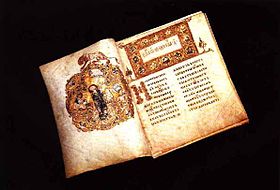Ostromir Gospels

The Ostromyr Gospels (Ukrainian: Остромирово Євангеліє) is the oldest dated book of Kyivan Rus'. Archeologists have dated the Novgorod Codex, a wax writing tablet with excerpts from the Psalms, discovered in 2000, to an earlier time range, but unlike the Ostromir Gospels, it does not contain an explicit date. The Ostromyr Gospels was created by deacon Gregory for his patron, Posadnik Ostromir of Novgorod, in 1056 or 1057 (the year 6564, in his dating system), probably as a gift for a monastery. The Ostromyr Gospel is one of the most outstanding monuments of Old Church Slavonic literature in the ancient Rus redaction, which was created in Kyivan Rus. It is a testament of the Ukrainian language. The document captures typical features of the Ukrainian language.
The book[edit]
The "Ostromyr Gospel" contains gospel readings for Sundays and holidays. It was transcribed in 1056-1057 from a Bulgarian original, presumably in Kyiv by the deacon Gregory for the Novgorod governor Ostromyr, who is mentioned in the book as a relative of Prince Izyaslav Yaroslavych (according to the hypothesis of Andrey Poppe; the inscription mentions Ostromyr's wife Feofana, who could have been the daughter of Volodymyr Svyatoslavych and Anna of Byzantium). According to the hypotheses of Yuri Dyba and Ihor Mytsko, the prototype of the book's origin should be linked to the scriptorium of the Czech Benedictine Slavic monastery in Sázava, as evidenced by its calendar and artistic design. It is also probable that exiled monks from Sázava found refuge in Kyiv.
Later history[edit]
It is thought that the book was taken from one of Novgorod's monasteries to the personal collection of the Russian tsars in the Moscow Kremlin, where it was first registered in 1701. Peter the Great ordered that it be taken to St. Petersburg, where there was no mention of it until 1805, when it was discovered in the dressing room of the late Catherine the Great.
The Gospels were deposited in the Imperial Public Library in St Petersburg, where it remains. Alexander Vostokov was the first to study it in depth, demonstrating that the Church Slavonic of the manuscript reflects the Old East Slavic linguistic background of the scribe. The first facsimile edition was published under Vostokov's supervision in 1843.
In 1932, the gem-studded book-cover induced a plumber to break into a case, remove and steal the binding, and hide the parchments behind a bookcase. Although the book was quickly recovered, no replacement binding has been provided to date.
See also[edit]
- Codex Zographensis (late 10th century or early 11th century)
- Novgorod Codex (first quarter of the 11th century)
- Svyatoslav's Miscellanies (1073, 1076)
- Archangel Gospel (1092)
- Mariinsky Gospel (11th century)
- Mstislav Gospel (1117)
- Yuriev Gospel (1119)
- Halych Gospel (1144)
- Dobrila Gospel (1164)
- Pantaleon Gospel (12th century)
- Eusebius Gospel (1282)
- Chelm Gospel (13th century)
References[edit]
Further reading[edit]
- Evans, Helen C. & Wixom, William D., The glory of Byzantium: art and culture of the Middle Byzantine era, A.D. 843-1261, no. 198, 1997, The Metropolitan Museum of Art, New York, ISBN 9780810965072; full text available online from The Metropolitan Museum of Art Libraries
External links[edit]
- 1050s books
- History of Eastern Orthodoxy in Russia
- Gospel Books
- Memory of the World Register
- Cultural history of Russia
- National Library of Russia collection
- 11th-century biblical manuscripts
- 11th-century illuminated manuscripts
- Church Slavonic biblical manuscripts
- Cyrillic manuscripts
- Cyrillo-Methodian studies
- Church Slavonic literature
